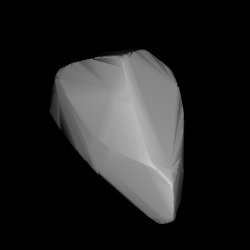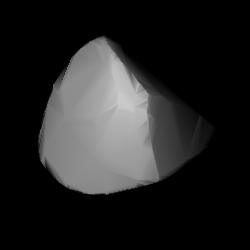Related Research Articles
1516 Henry, provisional designation 1938 BG, is a stony asteroid from the middle region of the asteroid belt, approximately 20 kilometers in diameter. It was discovered on 28 January 1938, by French astronomer André Patry at Nice Observatory in southeastern France. It is named for French astronomers and opticians, Paul and Prosper Henry.
1179 Mally, provisional designation 1931 FD, is an asteroid and long-lost minor planet from the central region of the asteroid belt, approximately 13 kilometers in diameter. Discovered by Max Wolf in 1931, the asteroid was lost until its rediscovery in 1986. The discoverer named it after his daughter-in-law, Mally Wolf.
1091 Spiraea, provisional designation 1928 DT, is a carbonaceous Cybele asteroid from the outer regions of the asteroid belt, approximately 36 kilometers in diameter. It was discovered on 26 February 1928, by astronomer Karl Reinmuth at the Heidelberg-Königstuhl State Observatory in southwest Germany. The asteroid was named after Spiraea, a genus of plants.
1159 Granada, provisional designation 1929 RD, is a dark background asteroid and relatively slow rotator from the inner regions of the asteroid belt, approximately 30 kilometers in diameter. It was discovered on 2 September 1929, by astronomer Karl Reinmuth at the Heidelberg Observatory in southwest Germany. The asteroid was named for the Spanish city and province of Granada.
1194 Aletta, provisional designation 1931 JG, is a carbonaceous asteroid from the outer region of the asteroid belt, approximately 55 kilometers in diameter. It was discovered on 13 May 1931, by South African astronomer Cyril Jackson at Johannesburg Observatory in South Africa. It was later named after the discoverer's wife Aletta Jackson.

1551 Argelander, provisional designation 1938 DC1, is a background asteroid from the inner regions of the asteroid belt, approximately 10 kilometers (6.2 miles) in diameter. It was discovered on 24 February 1938, by Finnish astronomer Yrjö Väisälä at the Turku Observatory in southwest Finland. The likely S-type asteroid has a rotation period of 4.1 hours. It was named after German astronomer Friedrich Argelander.

1349 Bechuana, provisional designation 1934 LJ, is a background asteroid from the outer regions of the asteroid belt, approximately 26 kilometers in diameter. It was discovered on 13 June 1934, by South-African astronomer Cyril Jackson at the Union Observatory in Johannesburg. The asteroid was named for the former Bechuanaland, what is now the Republic of Botswana.

1635 Bohrmann, provisional designation 1924 QW, is a stony Koronian asteroid from the outer region of the asteroid belt, approximately 17 kilometers in diameter. It was discovered on 7 March 1924, by German astronomer Karl Reinmuth at Heidelberg Observatory in southern Germany, and named for astronomer Alfred Bohrmann.

1633 Chimay, provisional designation 1929 EC, is a Themistian asteroid from the outer region of the asteroid belt, approximately 37 kilometers in diameter.

1274 Delportia, provisional designation 1932 WC, is a stony Florian asteroid from the inner regions of the asteroid belt, approximately 10 kilometers in diameter. It was discovered on 28 November 1932, by Belgian astronomer Eugène Delporte at Uccle Observatory in Belgium. It was named after the discoverer himself.
9298 Geake, provisional designation 1985 JM, is a Mitidika asteroid from the central regions of the asteroid belt, approximately 12 kilometers in diameter. It was discovered on 15 May 1985, by American astronomer Edward Bowell at Lowell Observatory's Anderson Mesa Station near Flagstaff, Arizona, United States. The asteroid was named for British astronomer John E. Geake.
1995 Hajek, provisional designation 1971 UP1, is a metallic asteroid from the middle region of the asteroid belt, approximately 13 kilometers in diameter.
1732 Heike, provisional designation 1943 EY, is a stony Eoan asteroid from the outer region of the asteroid belt, approximately 24 kilometers in diameter.
2016 Heinemann, provisional designation 1938 SE, is a carbonaceous Themistian asteroid from the outer regions of the asteroid belt, approximately 22 kilometers in diameter. It was discovered on 18 September 1938, by German astronomer Alfred Bohrmann at Heidelberg Observatory in southwest Germany, and later named after ARI-astronomer Karl Heinemann (1898–1970).
1690 Mayrhofer, provisional designation 1948 VB, is a carbonaceous asteroid from the outer region of the asteroid belt, approximately 32 kilometers in diameter. It was discovered on 8 November 1948, by French astronomer Marguerite Laugier at Nice Observatory in south-east France. It was later named after Austrian amateur astronomer Karl Mayrhofer.
2169 Taiwan, provisional designation 1964 VP1, is a carbonaceous Astridian asteroid from the central regions of the asteroid belt, approximately 17 kilometers in diameter. It was discovered on 9 November 1964, by astronomers at the Purple Mountain Observatory near Nanking, China. It was named for Taiwan.

3962 Valyaev is a dark Themistian asteroid from the outer region of the asteroid belt. The presumed C-type asteroid has a rotation period of 16.4 hours and measures approximately 15 kilometers in diameter. It was discovered on 8 February 1967, by Russian astronomer Tamara Smirnova at Nauchnyj on the Crimean peninsula, and later named after Russian astronomer Valerij Valyaev.
2022 West, provisional designation 1938 CK, is a stony asteroid from the middle regions of the asteroid belt, approximately 12 kilometers in diameter. It was discovered by German astronomer Karl Reinmuth at Heidelberg Observatory on 7 February 1938. The asteroid was named after Danish astronomer Richard M. West.
2752 Wu Chien-Shiung, provisional designation 1965 SP, is an Eoan asteroid from the outer regions of the asteroid belt, approximately 16 kilometers in diameter. It was discovered on 20 September 1965, by astronomers at Purple Mountain Observatory in Nanking, China. The asteroid has a long rotation period of 36.3 hours. It was named for Chinese-American nuclear physicist Chien-Shiung Wu.
1259 Ógyalla, provisional designation 1933 BT, is a Themistian asteroid from the outer region of the asteroid belt, approximately 32 kilometers in diameter. It was discovered on 29 January 1933, by German astronomer Karl Reinmuth at Heidelberg Observatory in southwest Germany. The asteroid was named for the Hurbanovo Observatory.
References
- 1 2 3 4 "JPL Small-Body Database Browser: 1470 Carla (1938 SD)" (2016-11-11 last obs.). Jet Propulsion Laboratory . Retrieved 3 April 2017.
- 1 2 3 Schmadel, Lutz D. (2007). "(1470) Carla". Dictionary of Minor Planet Names. Springer Berlin Heidelberg. pp. 117–118. doi:10.1007/978-3-540-29925-7_1471. ISBN 978-3-540-00238-3.
- 1 2 3 4 5 6 "LCDB Data for (1470) Carla". Asteroid Lightcurve Database (LCDB). Retrieved 3 April 2017.
- 1 2 3 4 Nugent, C. R.; Mainzer, A.; Bauer, J.; Cutri, R. M.; Kramer, E. A.; Grav, T.; et al. (September 2016). "NEOWISE Reactivation Mission Year Two: Asteroid Diameters and Albedos". The Astronomical Journal. 152 (3): 12. arXiv: 1606.08923 . Bibcode:2016AJ....152...63N. doi: 10.3847/0004-6256/152/3/63 .
- 1 2 3 4 Mainzer, A.; Grav, T.; Masiero, J.; Hand, E.; Bauer, J.; Tholen, D.; et al. (November 2011). "NEOWISE Studies of Spectrophotometrically Classified Asteroids: Preliminary Results". The Astrophysical Journal. 741 (2): 25. arXiv: 1109.6407 . Bibcode:2011ApJ...741...90M. doi:10.1088/0004-637X/741/2/90. S2CID 35447010.
- 1 2 3 4 Usui, Fumihiko; Kuroda, Daisuke; Müller, Thomas G.; Hasegawa, Sunao; Ishiguro, Masateru; Ootsubo, Takafumi; et al. (October 2011). "Asteroid Catalog Using Akari: AKARI/IRC Mid-Infrared Asteroid Survey". Publications of the Astronomical Society of Japan. 63 (5): 1117–1138. Bibcode:2011PASJ...63.1117U. doi: 10.1093/pasj/63.5.1117 . (online, AcuA catalog p. 153)
- 1 2 3 Tedesco, E. F.; Noah, P. V.; Noah, M.; Price, S. D. (October 2004). "IRAS Minor Planet Survey V6.0". NASA Planetary Data System – IRAS-A-FPA-3-RDR-IMPS-V6.0. Bibcode:2004PDSS...12.....T . Retrieved 15 June 2018.
- 1 2 3 Chang, Chan-Kao; Ip, Wing-Huen; Lin, Hsing-Wen; Cheng, Yu-Chi; Ngeow, Chow-Choong; Yang, Ting-Chang; et al. (August 2015). "Asteroid Spin-rate Study Using the Intermediate Palomar Transient Factory". The Astrophysical Journal Supplement Series. 219 (2): 19. arXiv: 1506.08493 . Bibcode:2015ApJS..219...27C. doi:10.1088/0067-0049/219/2/27. S2CID 17093124 . Retrieved 3 April 2017.
- 1 2 Pilcher, Frederick (April 2012). "Rotation Period Determinations for 31 Euphrosyne, 65 Cybele, 154 Bertha 177 Irma, 200 Dynamene, 724 Hapag, 880 Herba, and 1470 Carla". The Minor Planet Bulletin. 39 (2): 57–60. Bibcode:2012MPBu...39...57P. ISSN 1052-8091 . Retrieved 3 April 2017.
- 1 2 3 Waszczak, Adam; Chang, Chan-Kao; Ofek, Eran O.; Laher, Russ; Masci, Frank; Levitan, David; et al. (September 2015). "Asteroid Light Curves from the Palomar Transient Factory Survey: Rotation Periods and Phase Functions from Sparse Photometry". The Astronomical Journal. 150 (3): 35. arXiv: 1504.04041 . Bibcode:2015AJ....150...75W. doi:10.1088/0004-6256/150/3/75. S2CID 8342929 . Retrieved 3 April 2017.
- ↑ Veres, Peter; Jedicke, Robert; Fitzsimmons, Alan; Denneau, Larry; Granvik, Mikael; Bolin, Bryce; et al. (November 2015). "Absolute magnitudes and slope parameters for 250,000 asteroids observed by Pan-STARRS PS1 - Preliminary results". Icarus. 261: 34–47. arXiv: 1506.00762 . Bibcode:2015Icar..261...34V. doi:10.1016/j.icarus.2015.08.007. S2CID 53493339 . Retrieved 3 April 2017.
- 1 2 "1470 Carla (1938 SD)". Minor Planet Center. Retrieved 3 April 2017.
- ↑ Schmadel, Lutz D. (2009). "Appendix – Publication Dates of the MPCs". Dictionary of Minor Planet Names – Addendum to Fifth Edition (2006–2008). Springer Berlin Heidelberg. p. 221. Bibcode:2009dmpn.book.....S. doi:10.1007/978-3-642-01965-4. ISBN 978-3-642-01964-7.